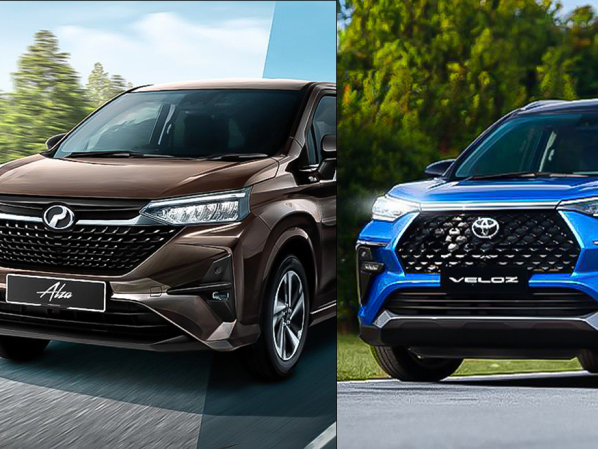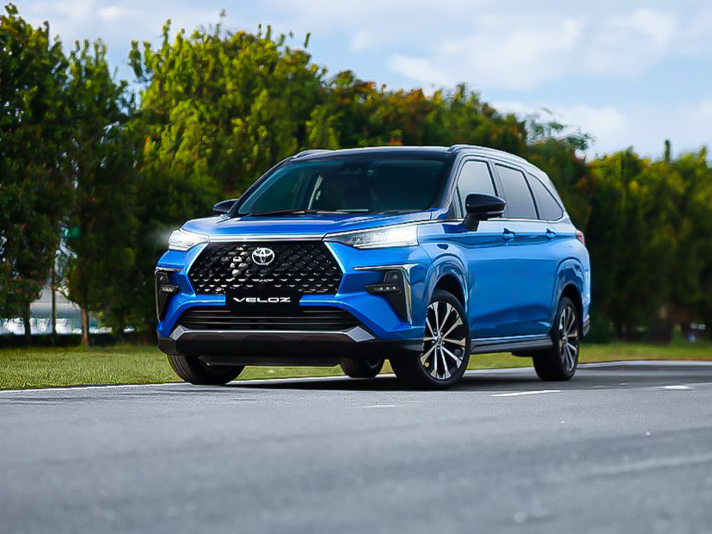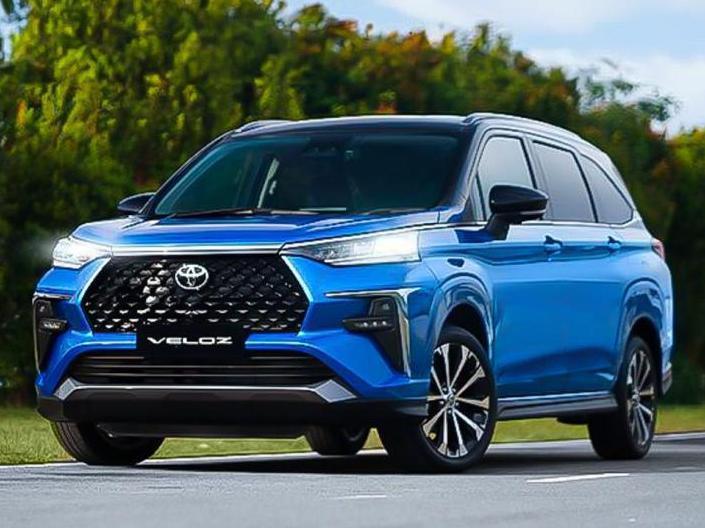Q
What's the Top Speed of Toyota Veloz?
The top speed of the Toyota Veloz is approximately 180 km/h (official data). During actual driving, the electronic speed limit may be set between 165 - 170 km/h to ensure safety. The Veloz is equipped with a 1.5L 2NR - VE Dual VVT - i naturally aspirated engine (maximum horsepower of 106hp at 6,000rpm, torque of 138Nm at 4,200rpm) and a 7 - speed CVT transmission. It focuses on fuel economy and urban driving comfort. So, its top - speed performance isn't very aggressive, but it's definitely sufficient for driving on Malaysian highways (where the legal speed limit is 110km/h). If you often drive long distances or carry a heavy load (like a full car of passengers plus luggage), the power will experience some lag at high - speed ranges. This is a common characteristic of the NA + CVT combination. Compared with MPVs in the same class, such as the Perodya Alza (top speed ~175km/h) or the Honda BR - V (~180km/h), the Veloz's performance is at the mainstream level. In terms of safety, it's recommended to abide by local speed - limit regulations. The handling stability and braking performance of the Veloz are at their best within the 120 - 140km/h range. Beyond this range, the vehicle will shake a bit more noticeably, especially on high - speed sections with strong cross - winds, so you need to drive carefully.
Special Disclaimer: This content is published by users and does not represent the views or position of PCauto.
Related Q&A
Q
Is the Toyota Veloz automatic?
Yep, the Toyota Veloz comes standard with an automatic transmission across all variants in the Malaysian market – specifically a 7-speed CVT that delivers smooth driving and decent fuel efficiency. Positioned as a family-friendly 7-seater MPV, it's built on the DNGA platform and powered by a 1.5L 2NR-VE Dual VVT-i naturally aspirated engine, churning out 106 hp and 138 Nm of torque. That makes it a solid fit for city commutes and family outings.
What's cool is that the Veloz's auto 'box also features a simulated shift function, letting you take manual control of the revs via paddle shifters for a bit more driving fun. For Malaysian buyers, automatics are a no-brainer in stop-and-go traffic, and Toyota's CVT tech has proven itself reliable in local conditions with relatively low maintenance costs.
Rivals like the Honda BR-V and Baojun 730 do offer auto options too, but the Veloz stands out with Toyota's strong brand reputation and standard safety kit like VSC (Vehicle Stability Control) across the range. And when it comes to used car value, Toyota autos generally hold their price well in Malaysia.
Q
Which country made Toyota Veloz?
The Toyota Veloz is a seven-seater MPV built in Indonesia, standing as a key player in Toyota's Southeast Asian lineup. It's primarily targeted at markets like Indonesia and Malaysia across the ASEAN region. Based on Toyota's DNGA platform, the Veloz shares its roots with the Avanza but leans harder into a youthful, stylish vibe. Under the hood, you'll find options like a 1.5-liter naturally aspirated engine or a 1.3-liter unit, paired with advanced safety features including Toyota Safety Sense.
Over in Malaysia, the Veloz is typically imported from Indonesia. Its strong value for money and practical interior space have made it a hit with local families. It's worth noting how Toyota's Southeast Asian strategy emphasizes regional production – Indonesia serves as a manufacturing hub, churning out multiple models for neighboring countries. This approach helps keep costs down and allows for quicker market responsiveness.
In Malaysia, the Veloz goes head-to-head with rivals such as the Honda BR-V and Baojun 530. However, Toyota's solid brand reputation and extensive after-sales network give it an edge, helping it maintain consistent market performance. If you're thinking about picking up a Veloz, it's a good idea to keep an eye on the latest promotions at local dealerships. Also, comparing specs and warranty terms with other models in its class will help you make the best choice for your needs.
Q
What is the alternative to the Veloz?
If you're in the market for an alternative to the Toyota Veloz, the Malaysian market offers several compelling 7-seater MPV or SUV options worth checking out. The Perodua Alza stands as its closest rival, sharing the same platform but with a more wallet-friendly price tag, along with a flexible 7-seat layout and efficient powertrain. The Honda BR-V is another solid pick, boasting a sportier exterior design and a reliable 1.5L engine—while third-row space is a bit tighter, it makes up for it with better handling dynamics.
Then there's the Mitsubishi Xpander, which turns heads with its unique styling and impressively spacious cabin, making it a top choice for practical-minded families. If you prefer the SUV look, the Baojun 530 or Chery Omoda E5 could fit the bill, offering similar passenger space but with a higher driving position.
All these models hover around the RM100k price range and come loaded with modern safety tech like ASA and ESC. Ultimately, your decision will boil down to design preferences, space needs, and brand loyalty. It’s worth noting that the Veloz’s hybrid variant shines when it comes to fuel efficiency—if saving at the pump is a top priority, you might want to hold off for more hybrid options to hit Malaysia’s shores.
Q
How to take veloz fast?
If you want to boost the acceleration of your Toyota Veloz, there are a few angles to tackle this. First off, make sure the vehicle is in tip-top shape. Regularly swap out the engine oil with a good quality one and replace the air filter to keep that engine breathing and running efficiently. Also, check your tire pressure—under-inflated tires create more rolling resistance, which definitely puts a damper on acceleration.
Next, get smart with the Veloz's drive modes. If it's got a Sport mode, flipping that on should sharpen up the throttle response and tweak the gearbox logic, giving you a bit more zip off the line. Another easy win? Lighten the load. Ditching unnecessary stuff from the cabin can make the car feel noticeably more eager when you hit the gas.
For those who want to take it a step further, you could look into aftermarket upgrades like a performance intake or exhaust system, or even an ECU remap to unlock more engine output. But heads-up—these mods might void your factory warranty, so it’s best to have a pro mechanic handle them.
Let’s be real though, the Veloz is a family-focused MPV. Its 1.5L Dual VVT-i engine is all about fuel efficiency and smoothness, not raw speed. If you’re craving more power, you might want to check out some of Toyota’s sportier models instead.
And here in Malaysia’s hot weather, try not to rag it too hard for extended periods—you don’t want the engine overheating. Keep up with regular maintenance on the gearbox and cooling system too, to make sure the car stays reliable for the long haul.
Q
How much is the monthly installment for the Veloz?
When it comes to the monthly installment for the Veloz, the exact amount hinges on several factors: the vehicle's selling price, your down payment percentage, the loan tenure, and the interest rate packages offered by banks or financial institutions. Take Malaysia's market as an example – the Veloz typically retails between RM90,000 and RM110,000. If you put down a 10% deposit and opt for a 7-year loan, with current bank rates hovering around 2.5% to 3.5%, you're looking at a monthly payout roughly in the RM1,100 to RM1,400 ballpark.
For the most accurate figures, though, I’d strongly advise reaching out directly to Toyota’s authorized dealers or your bank. Promotions or special loan deals can often tweak those repayment numbers. Also, when weighing loan options, don’t just fixate on the monthly hit – keep an eye on the total interest you’ll fork out and the loan’s flexibility, like early repayment terms or the risk of fluctuating interest rates.
As a 7-seater family SUV, the Veloz packs a 1.5L Dual VVT-i engine paired with a 7-speed CVT, and it’s got solid fuel efficiency to boot. It’s a solid pick if you’re a family-focused buyer who prioritizes practicality and space. Before signing on the dotted line, shop around and compare loan plans from different banks, and make sure to assess your budget carefully to keep those monthly payments stress-free in the long run.
Q
Does Veloz have auto hold?
As it stands, the Perodua Veloz doesn't come with an Auto Hold function. This feature is typically found on higher-spec trims or more premium models, designed to automatically keep the brakes engaged when you come to a temporary stop, so you don't have to keep your foot planted on the brake pedal. It's a real convenience boost, especially in stop-and-go traffic or when waiting at red lights.
Now, don't get me wrong, the Veloz focuses on family practicality and great value for money. It does come loaded with safety features like Hill-Start Assist and Electronic Stability Control. But Auto Hold? Yeah, that's not part of its standard or optional kit.
So, for Malaysian buyers who really have their heart set on Auto Hold, it might be worth casting an eye over other models in the same class or moving up a segment. Some Japanese or German brands, for instance, often include this feature in their mid-size SUVs or MPVs.
And hey, when you're checking out specs, always best to hit up the official owner's manual or chat with an authorized dealer to make sure you're getting the full lowdown. That way, you can pick the ride that's perfect for your needs.
Q
What is the fuel consumption of the Toyota Veloz at 100km?
According to official figures, the Toyota Veloz delivers around 6.1 to 6.3 liters per 100 kilometers in combined driving conditions. Of course, actual numbers can vary a bit depending on your driving style, the roads you take, and how the vehicle's spec'd out. This 1.5-liter naturally aspirated engine paired with a D-CVT gearbox makes for a pretty fuel-efficient 7-seater MPV – definitely a solid pick for Malaysian families.
It's worth keeping in mind that fuel economy can take a hit if you're cranking the AC non-stop, carrying heavy loads, or stuck in bumper-to-bumper traffic. To keep those consumption numbers in check, regular tire and engine maintenance is a good idea. Stacked up against its classmates, the Veloz sits somewhere above average for fuel efficiency, which makes it a smart option if you're doing a lot of highway miles. And with Malaysia's warm climate, using the right viscosity oil can help squeeze out even better fuel efficiency.
Q
How heavy is a Toyota Veloz?
According to official specs, the Toyota Veloz tips the scales at around 1,150 to 1,200 kilograms curb weight. Exact numbers can vary slightly depending on the trim level and configuration—like whether you opt for the 1.5-liter naturally aspirated engine paired with a CVT transmission in front-wheel drive, or go for the seven-seater layout. Positioned as a family-friendly multi-purpose vehicle, its weight is cleverly balanced to strike a chord between fuel efficiency and stability, making it a solid pick for both Malaysian city commutes and longer highway drives.
To dig a little deeper, a car's weight plays a big role in how it drives and sips fuel. The Veloz's lightweight design definitely helps with nimbleness, especially when zipping through traffic. Plus, that 1.5L engine's tuned to deliver good low-end torque, which really suits our local road conditions where you need that extra pull for quick overtakes or navigating busy streets.
When you're out shopping for one, besides checking the weight, Malaysian buyers should also keep an eye on the ground clearance—it's about 200mm on the Veloz—and how the suspension's set up. These things together make a big difference in how the car handles during the rainy season or on those rough country roads. Oh, and don't forget: keeping your tire pressure in check and avoiding overloading will go a long way in keeping your fuel consumption low and your ride safe.
Q
Is Toyota Veloz the same as Rush?
The Toyota Veloz and Rush are definitely platform-sharing siblings in the Malaysian market, but they’ve got clear differences when it comes to styling, trim levels, and target audiences. The Veloz rolls in from Toyota’s Indonesian production line, leaning into a sportier vibe with slightly higher-spec features—think LED headlights and a more polished interior. The Rush, on the other hand, sticks to that traditional, rugged SUV look and usually comes with a friendlier price tag.
Under the hood, both share the same 1.5L 2NR-VE engine and transmission setup, so you’re looking at pretty similar power delivery and fuel economy. But where they diverge is who they’re trying to attract: the Veloz seems tailor-made for younger families, while the Rush caters more to the practicality-first crowd. It’s worth mentioning that Toyota often tweaks specs for the Malaysian market based on local tastes—you might find more tech options up for grabs with the Veloz, for example.
If you’re torn between them, start by asking yourself what matters more: the sleeker, sportier design or the more utilitarian approach. And do yourself a favor—head to a dealership for a test drive to feel the chassis tuning difference. The Veloz typically leans harder into ride comfort with its suspension setup.
This "twin model" strategy is pretty common for Toyota in Southeast Asia, kind of like how the Alphard and Vellfire play off each other. It lets them cover different niches without starting from scratch each time, which keeps costs in check too.
Q
What is the top speed of the Toyota Veloz?
The Toyota Veloz tops out at around 170 km/h. Under the hood of this 7-seater MPV lies a 1.5-liter 2NR-VE Dual VVT-i engine, churning out 106PS and 138Nm of torque, paired with a D-CVT gearbox. For a family hauler, the power delivery is more than adequate. Let's be real, the Veloz is all about practicality and comfort – think generous cabin space and fuel efficiency – not straight-line speed. That 170 km/h max speed easily handles Malaysia's highway speed limits of 110 km/h.
A big plus is Toyota Safety Sense, which brings active safety features like pre-collision warning, lane departure alert, and automatic high beams. These come in clutch on the open road, giving you that extra peace of mind. For Malaysian buyers eyeing an MPV like the Veloz, focus on the things that matter daily: how flexible the space is, how comfy the ride is, and what the maintenance costs look like. At the end of the day, with our local roads and typical family usage, top speed just isn't a priority.
Latest Q&A
Q
Does the 2020 Honda Accord have transmission problems?
The 2020 Honda Accord has performed well overall in the Malaysian market. Its CVT and 10-speed automatic transmissions (depending on the trim) are technically mature, with most owners reporting smooth and reliable operation. However, some isolated cases may experience slight low-speed hesitation or delayed shifting, which are common characteristics of CVT transmissions rather than malfunctions. Honda Malaysia has not issued any large scale recalls or technical bulletins for this model regarding the transmission. It is recommended to check the transmission fluid condition during regular maintenance to ensure optimal performance. For consumers considering a used 2020 Accord, it is advisable to conduct a pre-purchase inspection through an authorized Honda service center, focusing on reading transmission fault codes and historical data. Notably, while CVT transmissions are known for their fuel efficiency, driving style can affect their lifespan. It is recommended to avoid frequent hard acceleration to extend component longevity. If unusual shifting vibrations or warning lights appear, contact an authorized Honda service point promptly for professional diagnosis. All Honda service centers in Malaysia are equipped with dedicated diagnostic equipment to quickly identify issues.
Q
What year to avoid Accord?
In Malaysia, the Honda Accord is a popular mid-size sedan, but certain model years can have some common issues that buyers should watch out for when shopping around. Based on owner feedback and expert reviews, some 2013 and 2014 Accord models had problems with transmission jerking and electronic system glitches, especially the CVT-equipped versions, which might develop rough shifting after long-term use. Additionally, owners of 2008 to 2010 Accords have reported higher fuel consumption and suspension noises. While these don't affect driving safety, they could increase long-term maintenance costs. If you're buying a used Accord, it's better to prioritize models from 2015 onwards—they saw significant improvements in reliability and fuel efficiency. Malaysia's hot and humid climate means you should also pay extra attention to the car's air conditioning system and electrical wiring when checking it out. Regular maintenance can really help extend the vehicle's lifespan. If your budget allows, the new Accord's hybrid system performs better in terms of fuel savings and driving experience, making it a good fit for buyers who value eco-friendliness and comfort.
Q
Which is better, the 2019 or the 2020 Honda Accord?
Both the 2019 and 2020 Honda Accord are really popular mid-size sedans in the Malaysian market. They don't differ much in core specs, but the 2020 model gets some nice detail upgrades. On the outside, the 2020 Accord has subtle tweaks to the front grille and wheel designs, giving it a more modern look, plus there are new exterior color options. Inside, the 2020 version comes standard with an 8-inch infotainment screen and an upgraded Honda Sensing safety suite, including more responsive adaptive cruise control and lane-keeping assist – features that were optional on some 2019 trims. Under the hood, both models offer the 1.5T turbo engine or the 2.0L hybrid system, with similar fuel economy, but the 2020's CVT transmission feels smoother in its tuning. For Malaysian buyers, if your budget allows, the 2020's upgraded features are worth considering, especially the improved safety tech which is really handy for daily driving. It's worth noting that 2019 models might offer better value in the used car market, but make sure to check the service records carefully if you go that route. The Honda Accord is known in Malaysia for its reliability and low maintenance costs, so both model years are solid picks – it just comes down to your budget and how much you want the newer features.
Q
Which year of Accord is most reliable?
In the Malaysian market, the Honda Accord is a favorite among consumers for its reliability and durability, especially the ninth-generation models produced from 2013 to 2017, which deliver an outstanding overall performance. This generation comes with an optimized 2.4-liter naturally aspirated engine or a 3.5-liter V6, offering smooth power delivery and decent fuel efficiency. It's paired with either a CVT or 6-speed automatic transmission—both mature technologies with low failure rates. Additionally, the ninth-gen Accord features a solid body structure and a well-tuned chassis that balances comfort and handling, making it suitable for Malaysia's diverse road conditions. If your budget is tight, the eighth-generation Accord (2008–2012) is also a solid pick, though keep in mind that some high-mileage used units may have issues like worn steering gears or suspension bushings. When shopping for a used Accord, prioritize checking regular maintenance records and pay close attention to the upkeep of critical components like transmission fluid and timing chains. As for hybrid versions, the i-MMD system in the tenth-generation Accord (2018 onwards) performs reliably, but battery life will gradually decline with years of use—professional testing is recommended before purchase. Overall, the Accord ranks among the most reliable in its class, and with proper maintenance, it can stay in great shape for the long haul.
Q
How long will a 2020 Accord last?
The 2020 Honda Accord can typically clock 200,000 to 300,000 kilometers or more with regular maintenance and proper use. Its actual lifespan depends on the owner's driving habits, how often it's serviced, as well as road conditions and climate in Malaysia. Under the hood, it’s packing Honda’s reliable Earth Dreams engine paired with a CVT transmission—proven tech with solid durability. Sticking to regular oil changes, transmission fluid replacements, and maintaining key components like the brakes and suspension can seriously extend its road life. Malaysia’s hot and humid weather might take a toll on rubber parts (think belts and seals) and the battery, so it’s a good idea to check these every six months and opt for original or high-quality replacement parts. Also, the Accord holds its value pretty well in Malaysia’s used car market, and a solid service history can bump up its resale price even more. For long-term ownership, follow the official maintenance manual and head to authorized Honda service centers for upkeep—you’ll get professional technical support and genuine parts that way. If you’re planning to keep it for the long haul, consider periodic deep maintenance too, like fuel system cleaning and coolant replacement, to keep the car in top shape.
View MoreRelated News

Toyota Veloz vs Alza: Which 7-Seater Is Right for You?
Kevin WongJul 15, 2025

Toyota Veloz Interior Revealed: A 7-Seater Made for Malaysian Families
Kevin WongJul 14, 2025

Style Meets Space: A Deep Dive into the Toyota Veloz
JamesApr 14, 2025

The Toyota Veloz is Priced at RM 95k in Malaysia with TSS, Wireless CarPlay etc.
LienMay 3, 2024

In Malaysia, which sliding door MPVs are available?
MichaelOct 30, 2025
View More
















Pros
Cons